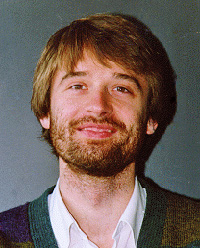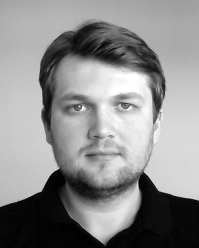
|  |
Nalini Anantharaman is a French mathematician
and professor at the University Paris-Sud, Orsay, France. Her research
interests are concentrated in Analysis and Mathematical Physics,
including Quantum Mechanics (such as the Schrödinger equation) and
wave propagation. She received the Henri Poincaré Prize in 2012. She
is Vice-President of the Société Mathématique de France.
|
 |
| Martin Andler teaches mathematics at the
University of Versailles Saint-Quentin; he has held visiting positions
at MIT and Rutgers University. His research focuses on two main areas:
representation theory of Lie groups, and the history of 20th century
mathematics. He is the chairman
of Animath, a French organisation
promoting mathematics for kids.
|
 |

|
 |

|  |
Alexander Bobenko is a professor of Mathematics at the
Technische Universität Berlin, Germany. His fields of interest include
geometry, mathematical physics and applications - in particular
differential geometry, discrete differential geometry, integrable systems,
Riemann surfaces, and geometry processing. He is currently
coordinator of the DFG Transregional Collaborative Research
Center "Discretization in Geometry and Dynamics", a member of the
Executive Board of the Berlin Mathematical School, and a
member of the DFG Research Center "Matheon".
|
 |
|
John Conway is one of the most prolific mathematicians. He is probably best known for the "Game of Life," which he invented, as well as for "combinatorial game theory" that he developed (partly in collaboration): a very natural and simple definition that lead to a class of games with incredibly rich structure, containing the now-famous "surreal numbers." He has made substantial contributions to many other areas of mathematics, for instance group theory. He greatly enjoys spending time and discussing with students.
|
 |

|
 |

|  |
Hans Feichtinger is an Austrian mathematician and a professor in the Mathematical Faculty of the University Wien. He is editor-in-chief of the Journal of Fourier Analysis and Applications (JFAA) and associate editor to several other journals. He is one of the founders of and head of the Numerical Harmonic Analysis Group (NuHAG) at the University of Vienna. Today Feichtinger's main field of research is Harmonic Analysis with a focus on Time-Frequency Analysis.
|
 |
|
Gerhard Frey is a professor at Universität Duisburg-Essen, Germany. He is widely known for his work in Number Theory. His Frey curve was central to Wiles' proof of Fermat's Last Theorem. Frey was co-editor of the Manuscripta Mathematica. He was awarded the Gauss medal of the Braunschweigische Wissenschaftliche Gesellschaft in 1996 for his work on Fermat's Last Theorem. Since 1998, he has been a member of the Göttingen Academy of Sciences. In 2006 Frey received the Certicom ECC Visionary Award for his contributions to Elliptic Curve Cryptography. His research areas are Number Theory and Arithmetical Geometry, with applications to Coding Theory and Cryptography.
|
 |

|
 |

|  |
Matthias Görner obtained his Master degree in Computer Science and his PhD degree in Mathematics at Berkeley University. He was interested in Hyperbolic Geometry and had a PostDoc position at the University of Maryland, where he worked with Christian Zickert on representations of 3-manifold groups and developing software to compute them. Currently, Matthias is working at Pixar Animation Studio where he develops animation software. His interests include programming, animation, Tango, and the San Francisco Bay Area.
|
 |
|
Olga Holtz is a professor of Mathematics at the University of California-Berkeley, a professor of Applied Mathematics at Technical University Berlin, and a professor at the Berlin Mathematical School. She received the Sofja Kovalevskaja award in 2006 and a European Mathematical Society Prize in 2008. Among her research interests are Numerical Analysis, Approximation Theory, Commutative Algebra, Enumerative Combinatorics, Compressive Sensing and Probability. Her Erdös number is 3.
|
 |

|
 |

|  |
Ilia Itenberg is a professor at the Université Pierre et Marie Curie
(Paris 6), France, and a member of the Institut Universitaire de
France. His main fields of interest are Real Algebraic Geometry,
topology of algebraic varieties, Symplectic Geometry, Tropical
Geometry and Enumerative Geometry. He has authored numerous books,
articles, and technical papers on various aspects of mathematics. This
includes Tropical Algebraic Geometry, On Total Reality Of
Meromorphic Functions, and Mathematical Circles - Russian
Experience. The last book was written to encourage students from
secondary schools to develop recreational mathematical skills while
keeping in line with the Russian tradition of forming mathematics
study groups.
|
 |
|
Alexandre Kirillov is a professor at the University of Pennsylvania and is known for his works in the fields of Representation Theory, Topological Groups, and Lie groups. In 1962, Kirillov was the youngest Doctor of Science in the Soviet Union. During his school years, Kirillov was a winner of many mathematics competitions, and he is still an active organizer of Russian mathematics contests. Kirillov is an author of many popular school-oriented books and articles. In 2012, he became a fellow of the American Mathematical Society.
|
 |

|
 |

|  |
Victor Kleptsyn is a researcher at CNRS, in the Institute of
Mathematical Research of Rennes. His working themes are mainly
Dynamical Systems and Geometry. His belief is that most arguments,
theorems, and proofs in the mathematics should be visual, and
easily explicable, at least on the "why should it be true" level
of explanation.
|
 |
|
Yair N. Minsky is an American mathematician and is currently a
professor at Yale University, USA. He obtained his PhD degree at
Princeton University, USA, where his PhD advisor was William
Thurston. His main interests are Hyperbolic Geometry, particularly the
deformation and classification theory of hyperbolic 3-manifolds, and
the study of surfaces, particularly mapping class groups and their
structure from the point of view of Geometric Group Theory. He also
works in Teichmüller Theory and Holomorphic Dynamics. Together with
Jeffrey Brock and Richard Canary he gave a proof of the Ending
Lamination Conjecture of Thurston (in Hyperbolic Geometry).
|
 |

|
 |

|  |
Gaiane Panina is a professor at the St. Petersburg Institute for
Informatics and Automation of the Russian Academy of Science. Her
research interests are convex polytopes, Combinatorial Geometry,
polygonal linkages, with illustrations here. She particularly enjoys participation in mathematical schools, both lecturing and attending classes given by her colleagues.
|
 |
|
Dierk Schleicher is professor of mathematics at Jacobs University
Bremen. He obtained his PhD at Cornell University, NY, and held
visiting positions in Berkeley, Stony Brook, Paris,
Toronto, and München. His main research interests
are in Dynamical Systems and Chaos, especially in Holomorphic
Dynamics and the Mandelbrot set, and the dynamics of Newton's
root-finding method. He was one of the main organizers of the 50th
International Mathematical Olympiad (IMO) 2009 in Bremen.
|
 |

|
 |

|  |
Sergei Tabachnikov is a professor of mathematics at Penn State
University and is the Director of the MASS (Mathematics Advanced Study
Semesters) program at Penn State. His research interests include
Geometry, Topology, and Dynamical Systems; one of his favorite topics
is mathematical billiards. In 2013-15, he is serving as the Deputy
Director of ICERM (Institute for Computational and Experimental
Mathematics) at Brown University. He (co)authored several books,
including Mathematical Omnibus, a collection of 30 lectures on
classical mathematics. In 1988-90, Sergei headed the mathematical
section of Kvant (Quantum) magazine, a Russian monthly on
physics and mathematics for high school and college students.
|
 |
|
Vlad Vicol is an assistant professor at Princeton University, USA. He
obtained his PhD at the University of Southern California, Los
Angeles, and currently holds a visiting position at the Institut Henri
Poincaré, Paris, France. His main research interests are in Elliptic
and Parabolic Partial Differential Equations, Mathematical Fluid
Dynamics and nonlinear Stochastic Partial Differential Equations.
|
 |

|
 |

|  |
Don Zagier is an American mathematician whose main area of work is
number theory. In 1976, aged only 24, he became Germany's youngest
professor. Among many other things, he is known for discovering a
short and elementary proof of Fermat's theorem on sums of two
squares: it consists of a single sentence. He is currently one of
the directors of the Max Planck Institute for Mathematics in Bonn,
Germany, and a professor at the Collège de France in Paris,
France.
|
 |
|
Günter M. Ziegler is a professor at the Freie Universität,
Berlin. His interests are in connection of Discrete and Computational
Geometry (especially polytopes), algebraic and topological methods in
Combinatorics, Discrete Mathematics and the theory of Linear and
Integer Programming. He received numerous prizes, among them the 2001
Leibniz Prize for his research and the Communicator Award in 2008,
when he was a co-organizer of the "Year of Mathematics" in Germany. His writing includes Proofs from THE BOOK, which has been published in 14 different languages by now.
|
 |

|
















